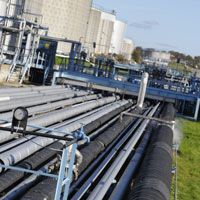Did you know that using the methane gasses generated from landfill sites are the least expensive form of clean energy we currently have available to us? It’s true, our waste when biodegraded anaerobically produce methane which is a flammable gas. Landfills are packed very tight and therefore do not allow oxygen to be used in the biodegradation process. This results in anaerobic microbes having an environment which allows them to thrive and break down the organic matter within the landfill cell. This also happens in Anaerobic Digesters where the by-product of the anaerobic biodegradation process produces the biogas Methane (CH4).
It is true that Methane gas is a potent greenhouse gas. It is also flammable and dangerous and as such it needs to be collected and converted into gases that are less impacting on the environment and/or to create clean energy. In the past many landfills would flare, or burn the methane to convert it to CO2 but over the years more and more landfills and businesses are recognizing that methane from landfills and anaerobic digestion can be used to create clean energy.
We are a long way from being a zero waste society and until we are we will have to deal with our waste. That waste if placed into anaerobic environments can generate methane which has a value that can offset our need for other fossil fuels.
Due to the stringent level of regulations the United States has the highest percentage of landfills with LFG (Landfill Gas) collection systems relative to any other country practicing landfilling. Nearly 60% of the worldwide capture of methane occurs in the U.S. even though the U.S. only generates 24% of the worldwide methane. From the perspective of the largest sources of methane emissions, landfills are the third largest. I provide these numbers to show that globally collecting and converting methane from landfills can provide the incentive to lower GHG (Greenhouse Gas) emissions. It should be noted that progress in lowering GHG emissions is best achieved by a concerted, integrated approach that employs all available technologies and methods, including reuse, recycling, composting, waste-to-energy, and landfilling with capture of LFG.
So here’s the question: What if all plastics were both recyclable and biodegradable, and would biodegrade in landfill environments?
If we do the math on the 31 billion plastic water bottles sent to a landfill instead of were recycled in 2006. It would result in enough energy to power a 100w light bulb for over 900,000 hours.
To calculate how much energy can be created from a plastic bottle enhanced with the ENSO additive take the weight of the bottle multiply it by % carbon, multiply by 1.33 (molecular weight of CH4 16 / molecular weight of carbon 12 – this converts the carbon to methane), then multiply by 22.4 (L/g – ideal gas law).
(bottle wt * bottle carbon %) * (methane mass 16 / carbon mass 12) * 22.4 L/g = vol. methane per bottle
(19.2 gram * 62.5%) * (1.33) * 22.4 = vol. of methane per bottle
(12) * (1.33) * 22.4 = 357.50 L * (1 m3/100 L) = .3575 m3
Once we know the volume of methane per bottle we need to convert that into how much energy can be created per volume of methane. The Thermal energy content of methane is approximately 26.73 – 32.7 kj/m3 therefore about (26.73 + 32.7) / 2 = 29.715 kJ/m3
.3575 m3 * 29.715 kJ/m3 = 10.623 kJ
1kJ/second = 1kW and considering a 100W light bulb:
10.623 kJ = 10.623 kW seconds * (1000 W/1 kW) * (1 hr/3600 s) = 2.95 W hr
To light a 100W light bulb for 1 hour would require 33.88 bottles:
100 W * (1/2.95 W hr) = 33.88
31 billion bottles = 31,000,000,000 bottles * (1 hr/33.88 bottles) = 914,759 hrs
